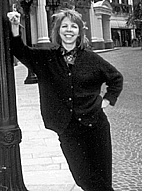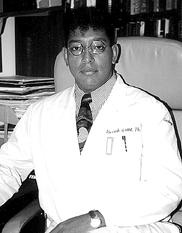
"Sometimes I would get depressed and think, 'Oh my god, my life is over!' But being the eternal optimist, I would get through it and keep on looking," says Sandberg, a former NICHD postdoc whose persistence recently paid off in the form of a tenure-track appointment at Georgetown University School of Medicine in Washington.
 |
Like Sandberg, many young biomedical researchers, be they Ph.D.s or M.D.s, aspire to a tenure-track appointment at a research-oriented academic institution. Although no one disputes the fact that competition for academic posts has grown fierce, especially among Ph.D.s, Sandberg is proof that some NIH-trained postdocs and clinical associates are defying the odds and securing academic posts even in this harsh job environment. Factors such as timing and luck may play key roles in winning a coveted academic position. However, former NIH postdocs and clinical associates who've landed academic jobs say their experiences have taught them that there are concrete steps that young researchers-and their mentors-can take to improve their chances of finding employment in academia.
Like most successful job hunters, Sandberg, an assistant professor of medicine and pharmacology at Georgetown, says she did not limit her search to advertised openings. Instead, she sent letters and résumés to all the chairs of departments that matched her research interests, even those located in regions where she really didn't want to live. In the end, Sandberg's "mass mailing" effort paid off, although by a more circuitous route than she had originally envisioned. A departmental chairman at Georgetown, who did not call Sandberg in for an interview, forwarded her résumé to a division head at a Florida institution, whom Sandberg had already written. Georgetown later recruited the Florida researcher and gave him the go-ahead to expand the division's research program-at which point he contacted Sandberg for the job she eventually got. "It helps to have your name thrown around by as many people as possible," Sandberg observes.
Derrick Grant, a former NIDR postdoc who recently took a tenure-track post at the Cardeza Foundation of Jefferson Medical College in Philadelphia, agrees that name recognition is a valuable asset in the job search. Grant credits his mentors Hynda Kleinman, George Martin, and Kenneth Yamada with driving home the importance of scientific networking. "Collaboration was highly stressed in our lab, and travel to scientific meetings was encouraged," says Grant, adding that the intensive collaboration also helped him average about five publications a year during the six years he was at NIH.
 |
Sean Donevan, who is leaving NINDS after five years to take a non-tenured, two-year appointment as a research assistant professor at the University of Utah in Salt Lake City, also sings the praises of networking. Donevan says he thinks a major reason he got his academic job was because of a contact he made with a Utah researcher at a meeting several years ago. Both scientists were doing research on the electrophysiology of the glutamate receptor, and when they ran into each other this year at a neurosciences meeting, the Utah researcher mentioned to Donevan that his department had an opening. "You definitely have to talk to people," he says.
Another success story out of the same lab as Donevan, the Neuronal Excitability Section of the Epilepsy Research Branch, is Jong Rho, a clinical associate from 1992 to 1994 who is now a tenure-track assistant professor of neurology and pediatrics at the University of Washington School of Medicine in Seattle. In addition to publishing high-quality research, Rho singles out two key factors that can improve a young scientist's employment outlook: having an interested mentor and being encouraged to make presentations at national meetings. "The mentor is important because he knows the people who are looking to hire ... . Presentations are important because you can meet program heads and other important people," says Rho, adding that it would be helpful if NIH would provide more money for junior researchers to attend national meetings. Rho also commends his mentor, Michael Rogawaski, and other senior scientists who remember to weave the names of their postdocs and clinical associates into their conversations with other influential researchers. "people whose names are never brought up to outside department heads often have a more difficult time" finding jobs, Rho says.
If a young researcher can't get the mentorship or guidance he or she needs within NIH, Sandberg, who spent her seven years as a fellow in NICHD's Endocrinology and Reproduction Research Branch, suggests following her lead and asking a former Ph.D. adviser for help. "They have no conflict of interest. They usually have a special feeling for you. And they know what search committees are looking for," she says.
Grant says his mentors' emphasis on making sure that postdocs took the time to polish their papers and presentations helped him put his best foot forward in application letters and job interviews. "Hynda [Kleinman] always told us that you must write clearly, tell a good story. To impress people you must do more than just show them data-you have to stand out."
Mentors and NIH seminars can also help to prepare NIH-trained postdocs for what many consider their biggest hurdle in the search for academic employment: writing grants.
To acquaint the young scientists in her lab with the dog-eat-dog world of grantsmanship, Kleinman insisted that they submit grant proposals to corporate competitions, even though odds weren't good that the fledgling grant writers would win. In addition, Grant said he took the NIGMS seminar on grant writing-twice. (See Grant Writing Workshop) "The first time a lot of it didn't sink in," says Grant, an assistant professor of medicine, pathology, and cell biology who is now busy trying to craft investigator-initiated (R01) grant applications that are "sexy" enough to be in the top 3ñ5% of projects funded on the first round. "It's really horrible out here now. You've got to make the study sections go, 'wow.'"
R. Mark, who landed a tenure-track associate professor position at the University of St. Louis in Missouri after 12 years at NIAID's Laboratory of Viral Diseases, says that it is particularly difficult for postdocs who are "longer in the tooth" to find an academic position if they don't bring along any grant support.
"Institutions want to be assured that you are going to attract funding, especially in the funding climate that we have now," says Buller, noting that the only major difference between himself and another candidate for an academic position that he did not get was that the other applicant had grant money. Now that the roles are reversed and he's serving on search committees himself, Buller reports that the first two questions used in evaluating a candidate are: "Will this person be able to bring in money?" and "Will this person's research interest be complementary to ours?" To compensate for the lack of funds, Buller, an expert on poxvirus pathogenesis who did not get tenure at NIH, says he believes that intramural researchers who want something better than an entry-level academic position must work hard to cultivate an outstanding reputation in their fields. "You have to bring something special to the table that they are willing to pay more money for," he says. Otherwise, according to Buller, the university will opt for an outside researcher with grants or a less experienced researcher who can be paid a lower salary.
Sandberg, who thinks it would be a good idea if NIH set up a highly selective intramural grants competition to give postdocs a taste of the extramural grants process, says she tackled her lack of grantsmanship head-on in her application letters and her interviews. "It is very important to show where you want to go, not just to talk about what you have been doing. You have to set a clear direction-to put forth your ideas in terms of grant proposals. Let them know that you are thinking along that line," she says. "If you come from NIH, they know you can publish. They don't know if you can write a grant." In addition, Sandberg suggests that NIH fellows with considerable research experience-but no grant support-may want to do what she did: negotiate an assistant professor position with immediate promotion to associate professor upon receipt of a major grant.
Now that she's exchanged her job-seeking anxieties for grant-writing pressures, Sandberg recommends that NIH postdocs start looking for employment after three years of research. "There's really no advantage to staying at NIH longer because you will start at ground zero in academia until you start bringing in grant dollars," she explains.
As a final tip for academic job hunters, Sandberg suggests following up on applications and learning from failures. "If you're rejected for an opening, talk to the chairman and ask why you were rejected-and then, if it's something you can fix, fix it," she says. For those who would scoff at her job-seeking mantra of "Don't give up," Sandberg offers the case of an excellent postdoc from Georgetown who searched for a long and frustrating 2 1/2 years until recently landing an academic position-not just any post-but a terrific job that was exactly what he wanted.